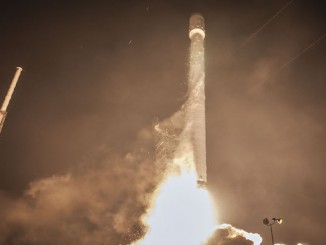
A government communications satellite to link Indian citizens with telemedicine, education, and other services rocketed into orbit Thursday on an Indian Polar Satellite Launch Vehicle.
The CMS 1 satellite, formerly known as GSAT 12R, is on track to replace India’s GSAT 12 spacecraft in geostationary orbit providing telecom services across the Indian subcontinent and neighboring islands.
The roughly 1.5-ton satellite took off on the PSLV at 5:11 a.m. EST (1011 GMT) Thursday, or 3:41 p.m. local time in India.
The mission, designated PSLV-C50, departed from the Second Launch Pad at the Satish Dhawan Space Center on India’s east coast and headed east-southeast over the Bay of Bengal. The 145-foot-tall (44.4-meter) PSLV flew in its most powerful configuration Thursday with six strap-on solid rocket boosters.
Four of the boosters ignited with the PSLV’s solid-fueled core stage to propel the rocket off the launch pad with around 1.7 million pounds of thrust. The two other strap-on motors fired around 25 seconds after liftoff to give the rocket an additional boost.
All six boosters burned out and jettison in the first 90 seconds of the flight, followed by burnout of the PSLV’s core stage motor at T+plus 1 minute, 49 seconds, when the first stage separated to allow the second stage’s hydrazine-fueled Vikas engine to ignite.
The liquid-fueled second stage, solid-fueled third stage motor, and liquid-fueled fourth stage fired in succession to place the CMS 1 spacecraft into an elliptical geostationary transfer orbit ranging between 176 miles (284 kilometers) and 12,831 miles (20,650 kilometers) in altitude, with an inclination of 17.86 degrees to the equator.
Live video from the PSLV’s fourth stage showed the CMS 1 satellite receding into darkness as the rocket soared a few hundred miles over the night side of the Earth.
CMS 1 separation confirmed. India’s latest communications satellite, formerly named GSAT 12R, has arrived in the correct orbit after a successful launch. https://t.co/nputi2Im6j pic.twitter.com/airdilglsP
— Spaceflight Now (@SpaceflightNow) December 17, 2020
In the coming days, the Indian-built satellite’s own propulsion system will guide CMS 1 to its permanent operating orbit more than 22,000 miles (nearly 36,000 kilometers) over the equator. In geostationary orbit, the spacecraft will circle Earth at the same rate of the planet’s rotation, giving CMS 1 a continuous view of India.
The launch of India’s PSLV Thursday marked the second and final Indian space launch of 2020, following a months-long suspension of launch activity due to the COVID-19 pandemic. India resumed satellite launches last month with a PSLV mission that carried an Indian Earth-imaging satellite into orbit, plus several small commercial payloads for customers in the United States and Europe.
The satellite CMS 1 is replacing, GSAT 12, was launched in 2011 on a previous PSLV mission for a planned eight-year mission beaming telemedicine, remote education, weather forecasts and other public service information to rural communities.
The CMS 1 spacecraft, fitted with a C-band communications payload, will take over those duties. The satellite’s communications payload will reach users across the Indian mainland, the Andaman and Nicobar Islands, and the Lakshadweep Islands, according to the Indian Space Research Organization.
Thursday’s mission was the 52nd flight of a Polar Satellite Launch Vehicle, India’s workhorse rocket, since its debut in 1993.
Email the author.
Follow Stephen Clark on Twitter: @StephenClark1.



